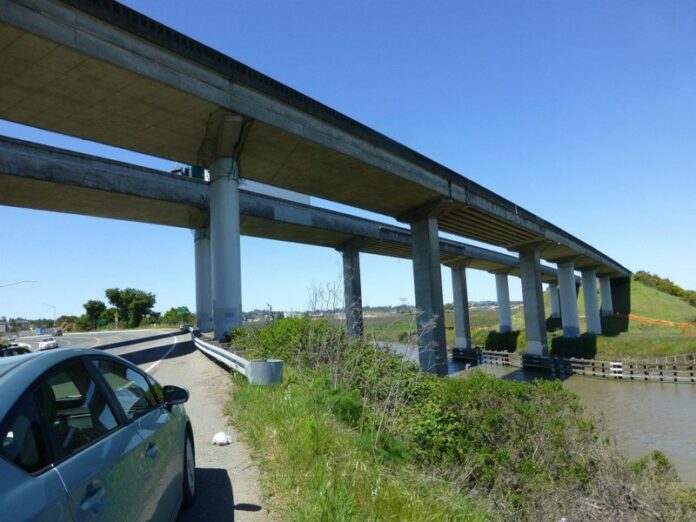Federal and state wildlife officials have made virtually no efforts to amend a Caltrans-related situation in Petaluma that has directly caused the deaths of more than a hundred migratory birds currently nesting under a pair of freeway overpasses, according to a local bird rescue center.
Veronica Bowers, of Songbird Care & Conservation in Sebastopol, has almost singlehandedly monitored and investigated the matter since March, when she first called Caltrans to warn that netting dangling from beneath the Highway 101 bridge over the Petaluma River was likely to cause problems for federally protected cliff swallows, which migrate north from South America each year and build nests in, among other places, the freeway overpasses that cross Lakeville Highway and the Petaluma River.
But Bowers says nobody at Caltrans responded, even after she called and left a second voice message. This was still before any birds had been confirmed dead in the newly installed netting dangling from the bridges and that is supposedly part of an upcoming construction project.
Then the death toll began, says Bowers, who saw the first entangled swallows on April 7 under the Petaluma River bridge.
“There were well over a dozen cliff swallows dead or dying in the nets,” Bowers says.
She says she called Caltrans again, and then contacted the two major agencies charged with protecting wildlife—the federal Fish and Wildlife Service and the state Department of Fish and Wildlife—to file a complaint. Caltrans never responded, while each wildlife management agency took three days to do so, according to Bowers.
“It was appalling,” Bowers says. “Each day they didn’t answer, I kept going back and finding more dead birds.”
Bowers says she finally had brief telephone conversations with both the Fish and Wildlife Service and the Department of Fish and Wildlife.
“They said they’d look into it, and that’s been the status since,” she says.
By now, the death toll of cliff swallows at the two Highway 101 overpasses may be approaching 200, according to Bowers. The majority of the birds have been entangled under the Petaluma River overpass, where a contracting company called CC Myers Inc. first installed the nets as part of preliminary work on an upcoming $77 million retrofit. The nets are presumably meant to protect the birds—or at least keep them away from the barrier while retrofit work is underway. The Fish and Wildlife Service forbids construction projects from harming nesting swallows.
Yet law enforcement officials have hardly jumped to amend the situation. On Friday, Janice Mackey, a spokeswoman with the California Department of Fish and Wildlife, said that Caltrans had already “resolved” the problem, adjusting the nets so that swallows would no longer try and squeeze between small openings in the barrier.
“Caltrans fixed that issue on Monday,” Mackey says.
But according to Bowers, at least nine more swallows were found dead by her organization in the netting between Monday and Friday of last week.
When pressed for a better answer, Mackey says the department told her it would call back with an update. The return call never came.
At the federal level, Michael Woodbridge of the Fish and Wildlife Service would say only that his agency’s law enforcement officers were investigating the problem. He said he could offer no further comment.
Caltrans officials did not return multiple calls from the Bohemian seeking comment, but have already told other reporters that their project planners have strived to amend the situation by cinching up the netting at openings through which swallows were attempting to access their traditional nesting grounds.
Bowers says no obvious fixes have been made and that any assurance that the problem has been resolved “is misinformation.” She has repeatedly suggested alternate methods of keeping the birds away from the construction site, such as silicon-based paint or Teflon sheathing, to no avail.
At the Bird Rescue Center in Santa Rosa, executive director Mary Ellen Rayner says she has personally called state and federal authorities three times, and that her staff of volunteers has sent emails to various officials demanding action—and even suggesting solutions, like alternative barriers made of glass or plastic—that would solve the issue.
“It seems to me that they’re just ignoring us,” says Rayner, who speculates that higher-profile birds like raptors might receive more efficient response in a comparable scenario. “Whatever the reason, these regulatory agencies aren’t enforcing laws that should protect migratory birds.”











